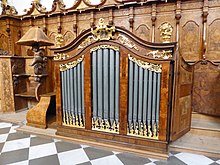Choir organ
The choir organ is a smaller organ in the choir of large churches, which today is normally used to design smaller forms of worship.
definition
A choir organ is an independent instrument and must be distinguished from a remote or auxiliary unit , which are only set up for spatial or sound effects.
history
The choir organ was originally used primarily for the musical accompaniment of the singing during the hours of prayer several times a day by monks or canons in the choir of monastery or collegiate churches. From the baroque onwards , a larger main organ is usually also available to accompany the parish singing. In France and England it has also been customary since the 19th century to employ at least two organists , each of whom is only responsible for one of the two organs.
In rare cases the choir organ also serves as the main organ and is correspondingly larger in size (e.g. in the Marienstatt Abbey in the Westerwald). Another variant can be found in the monastery churches of Weltenburg and Frauenzell . Here the organ is designed as a parapet organ with two prospects .
A rarity is the existence of two choir organs next to each other, which are then also referred to as "Gospel organs" (on the left side when looking forward to the altar) and "Epistle organs" (right side). Examples of this are the organs by Karl Joseph Riepp in St. Alexander and Theodor in Ottobeuren from 1766 and the two choir organs of the former abbey church of Ebrach monastery near Bamberg . They were built by Johann Christian Köhler in 1753 and 1759/60. Since the two organists have eye contact here and the two instruments for choir organs are relatively large, concert music for two organs is also possible.
Usage today
To enable better contact between the organist and the congregation, a choir organ is often installed in large churches. This is used for types of worship that take place in a smaller setting, or it serves as an accompanying instrument for larger, concert performances in the choir room. Choir organs are sometimes completely independent instruments, but they can also be part of a larger organ system. Today, larger positives , but also organs that were erected on the nave wall near the church's folk altar, are often referred to as “choir organs”.
Individual evidence
- ↑ Winfried Ellerhorst: Handbook of Organ Studies . Benziger, Einsiedeln 1936, p. 602.


